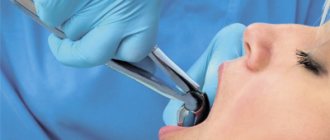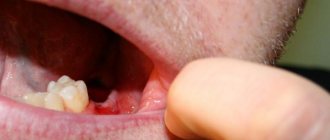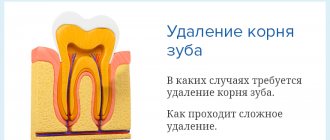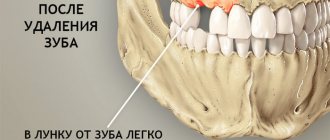For many people, rotten wisdom teeth pose a real and very serious threat to the health of the entire oral cavity - problematic third molars or, as they are also called, “eights” cause a lot of trouble for their owners. They erupt much later than the rest of the dentition (at about 20-25 years) and often become a problem already at the eruption stage.
Removal of wisdom teeth due to caries
Why are wisdom teeth most often affected by caries?
Most often, caries of wisdom teeth develops due to the fact that they are located far enough away and do not participate in the act of chewing.
And if the teeth are not involved in the act of chewing, then it is extremely difficult to clean them due to the fact that the teeth are cleaned not only during hygiene, but also during each meal - on their own. On the picture
– what caries looks like on the bottom eight.
You can see how the lower wisdom tooth is removed due to caries HERE. By the way, there, in clinical cases, you can see how the removal of an upper wisdom tooth occurs.
Often the patients themselves neglect these teeth, brush the eights less carefully and caries develops quite quickly, the wisdom tooth begins to hurt, so it will be easier to remove such a tooth than to treat it.
Can caries cause wisdom tooth removal?
Should wisdom teeth with caries be removed? Yes. Removal of the figure eight, if there is caries, is carried out due to the inappropriateness of its treatment.
In most cases, we do not chew with these teeth, and treating wisdom teeth is quite difficult and problematic. And most importantly, this makes absolutely no sense.
Removing the bottom eight can be seen HERE
There is also a situation when the wisdom tooth is strongly inclined, “lying” and covered with caries. In this case, there is also absolutely no point in treating wisdom teeth.
.
If your wisdom tooth gets injured: chipped or cracked?
Should it be removed? A chip, crack, or injury to a wisdom tooth is a 100% indication for removal
wisdom tooth There is absolutely no reason to fight to save him.
Let's see how wisdom teeth led to crowded teeth
And how crowded teeth are eliminated with Star Smile aligners
The video shows how the 3D setup is done. I am commenting on the video, orthodontist Alexander Spesivtsev, clinical director of Star Smile, a doctor with many years of experience in the successful use of aligners in orthodontic practice. To restore straight dentition, the wisdom teeth themselves—the eights—had to be removed. At Star Smile, or rather in the clinics of its partners (more than 70 cities in Russia), any treatment begins with diagnosis and drawing up a virtual setup. The doctor takes photographs of the patient’s face, dentition, as well as x-rays and dental casts. Using special software, the obtained data is processed and a three-dimensional model of the patient’s dental system is obtained. And this already allows you to calculate the trajectory of tooth movement, treatment time, and the required number of sets of aligners. Also, the final result of the treatment will be visualized - the patient will be able to evaluate the aesthetics of the smile after treatment. Patients really like this approach - they can see their future smile, their straight teeth. The forecast of a 3D setup when straightening teeth with aligners comes true in almost 100% of cases. You see, this is completely different from correcting a “blind” bite, as is usually the case with braces. Everything is clear here, without any guesswork or assumptions.
Gevorkyan Oscar Vladimirovich
Candidate of Medical Sciences, Oral and Maxillofacial Surgeon, Central Scientific Research Institute, Scientific Consultant Star Smile “ If you are faced with questions
:
- To remove or not to remove wisdom teeth?
- How dangerous is it to remove wisdom teeth?
- When do wisdom teeth interfere with orthodontic treatment?
- and most importantly, is it possible to avoid the removal of “eights”?
Feel free to contact the doctors at Star Smile, they will help you understand this sometimes complex, but very important life problem for many.
Do not delay the decision in order to avoid possible complications in the future.” Since the Star Smile company is represented in all federal districts, large and medium-sized cities of Russia and interacts with many clinics and orthodontists, we offer you the opportunity to undergo a free consultation with high-quality orthodontists in your city , where you can discuss the problem of wisdom teeth and determine the optimal solution for you. To do this, you need to fill out the form below, a Star Smile medical specialist will contact you and help you by scheduling a consultation at a convenient time or providing your doctor’s contact information.
Don’t put off the problem of wisdom teeth “for later”!
Wisdom teeth during orthodontic treatment
Removal of wisdom teeth before orthodontic treatment
During the period of orthodontic treatment, when the bite is being corrected, the figure eights are also most often removed. Why?
Before orthodontic treatment, we need to remove teeth that are preventing all the remaining teeth - 28 teeth - from moving into place. As a rule, wisdom teeth do not provide freedom for such activities. We remove them and then perform orthodontic treatment.
In what cases are wisdom teeth not removed during orthodontic treatment?
In the case of large jaws, when the wisdom teeth are in an absolute row and they close correctly, in the correct occlusion, we do not need to remove them. We can leave them, we can also treat them, take care of them, like other teeth.
Impacted and dystopic wisdom teeth
Impacted wisdom tooth
- this is a tooth that has not erupted; it is located in the bone tissue, in the gum. The general practice is that few dentists decide to remove an impacted figure eight, since it is a complex procedure.
In the clinics of the German Implantology Center, removal of impacted wisdom teeth is carried out as planned; our experience allows us to perform surgery of this level.
Why don't wisdom teeth erupt?
The wisdom tooth does not erupt due to the fact that it is dystopic: there is a neighboring tooth in front of it, which is in the way.
This wisdom tooth is usually tilted. Or there is absolutely no room in the jaw, it is located at the corner of the jaw: there is no place for it to cut through, there is no way.
Dystopic tooth
A wisdom tooth is a tooth that is erupting or has erupted incorrectly. Or it cannot erupt and occupies the wrong position in the jaw.
Typically, such teeth displace other teeth, deforming the jaw. It is impossible to treat them, and straightening them is also extremely difficult. In these cases, we remove the dystopic wisdom tooth. As a result of dystopia, cheek injuries may also occur due to chronic biting. Therefore, it is better not to postpone the removal of the dystopic eight “for later”.
Why does figure eight caries occur?
According to statistics, caries of problem eights is much more common than caries of other teeth. At the same time, the main reasons for the development of carious lesions are not much different from those with damage to any other part of the jaw. These include:
- Hereditary factors.
- Poor hygiene.
- Excess sugars and fast carbohydrates in daily nutrition.
- A specific risk factor is the location of the third molar. Typically, the wisdom tooth erupts at an angle, which makes it difficult to properly clean it during daily hygiene procedures. In hard-to-reach areas, food debris accumulates, which serves as a breeding ground for bacteria. By fermenting carbohydrates, bacteria produce organic acid, which leads to caries of the upper or lower 8 teeth.
Removal of wisdom teeth in pregnant and lactating women
Removal of wisdom teeth in pregnant and nursing mothers
Is it possible to remove wisdom teeth during pregnancy? Pregnant and lactating women can have their wisdom teeth removed only in case of exacerbation of one of them or necessity, when it is impossible to solve this problem conservatively. In a planned manner, it is better to remove wisdom teeth after the end of the feeding period.
Are there any special features of removing wisdom teeth during pregnancy?
We try to perform tooth extraction on all our patients as carefully, comfortably, and carefully as possible. Therefore, as a rule, there are no technical features. But if any intervention in the form of wisdom tooth removal is urgently required (because there is no other alternative), we must consult with the attending physician - a gynecologist and, accordingly, coordinate all our actions.
What anesthesia is used when removing wisdom teeth in pregnant and lactating women?
In pregnant and lactating women, after consultation with a gynecologist, we, as a rule, perform anesthesia with a reduced level of adrenaline, so as not to provoke the onset of labor in the later stages, and not to provoke a miscarriage in the early stages.
Removal of a wisdom tooth near the maxillary sinus
If the wisdom tooth is located near the maxillary sinuses, there is a certain difficulty in such removal. Why?
If a wisdom tooth is located close to the maxillary sinus, there is a risk that during removal the tooth can be pushed into the maxillary sinus. If you make incorrect technical movements when removing a tooth, or work roughly in some way, you can harm the person and, accordingly, you will then need expensive long-term treatment to remove this tooth.
Removing the "hood"
Often, difficult eruption of a wisdom tooth leads to inflammation of the gums that cover it (“hood”). This causes enlargement of the lymph nodes, increased temperature, pain when chewing, injury to the gums and, as a result, rapid proliferation of pathogenic bacteria, leading to inevitable suppuration. This situation occurs quite often and is an indication for excision of gum tissue. If the “eight” under the hood is viable and does not cause inconvenience, then it is not removed.
Are there any specifics to removing wisdom teeth?
Of course, there are some peculiarities when removing wisdom teeth. The doctor’s task is to make the removal process as accurate as possible, as atraumatic as possible - in principle, like the rest of the teeth. But in the case of a wisdom tooth, there are some peculiarities of anatomy.
The peculiarities are that the figure-eight tooth is located quite far away and quite well hidden. But at the same time, using modern equipment, modern materials and having experience, you can remove wisdom teeth quickly and accurately enough without consequences or injuries.
What is the difference between removing top and bottom eights?
Removing a tooth in the lower jaw is more difficult. The reason lies in the greater density of the alveolar process and the branching of the roots. When removing lower third molars, the risk of breaking off a root fragment increases, so the operation has certain specifics. To completely eliminate pain, conduction anesthesia is used here. In this case, the nerve through which the pain signal is transmitted is blocked for a long time. In the upper jaw, infiltration anesthesia, the so-called “freezing,” copes with the task of effective pain relief.
Tooth extraction: painful or not?
The popular idea of discomfort during the removal of a “wise” tooth is nothing more than a myth. Even the most complex dental operations are performed without the slightest pain, and painless removal of the third molar has long become the standard of an ordinary clinic.
The latest generation carpule anesthetics leave no chance for pain. The needle of a carpule syringe is thinner, so its insertion into the tissues of the oral cavity is almost not felt. To relieve sensitivity of the gums at the injection site, it is first lubricated with an anesthetic gel.
Particularly susceptible people experience psychological discomfort from the sounds of rocking a tooth with forceps. To eliminate stress, dentists use sedatives. Extraction with sedation allows the patient to relax in the dentist's chair and relieves anxiety.
Competent removal of wisdom teeth
How to remove a wisdom tooth in the least traumatic way?
The wisdom tooth is removed atraumatically after carefully evaluating the computed tomography scan, talking with the patient, and assessing his clinical case. The tooth is separated - divided into parts if it has any bends, slopes, or several roots. And, accordingly, with the help of elevators, luxators - special dental instruments, it is carefully and carefully dislocated.
There is no need to worry about the appearance of some blood after wisdom tooth removal. The removal is carried out under the full supervision of a doctor; the wound after tooth extraction is sutured and sutures are applied. What follows is a standard rehabilitation protocol without any surprises for the patient. The only thing is that after the removal of a wisdom tooth (wisdom teeth), swelling of the mucous membrane is possible.
Why is atraumatic tooth extraction more preferable?
With this removal, the doctor takes care of the health of the patients. So that the healing takes place as comfortably as possible, so that there are no consequences after this, so that the patient in the near future, after 7-10 days, forgets that he had his wisdom tooth removed. It is after this time that possible swelling and pain after removal are completely removed.
What do patient reviews depend on?
Positive reviews will primarily depend on the experience and professionalism of the dental surgeon. It is better to find an experienced doctor rather than a young doctor straight out of medical school. Ideally, the doctor has experience in maxillofacial surgery and/or implantology. Read patient reviews about wisdom teeth removal in the comments to this article. We hope that our article on the topic: Wisdom tooth removal consequences photo - was useful to you!
Sources:
1. Higher prof. the author’s education in surgical dentistry, 2. Based on personal experience as a dental surgeon, 3. National Library of Medicine (USA), 4. “Outpatient surgical dentistry” (Bezrukov V.), 5. “Qualified removal of third molars” (Asanami WITH.).
Pain after wisdom teeth removal
How long does pain last after wisdom tooth removal?
Pain after the removal of wisdom teeth lasts differently, depending on the sensitivity of the person and how the healing proceeds in general. It hurts after removing the figure eight from several days to, maximum, 7-10 days. Naturally, all pain, all painful symptoms from wisdom tooth removal subside over time.
What should you do if the wound hurts for a long time after wisdom tooth removal?
If you experience prolonged pain after wisdom tooth removal, you should contact your doctor as soon as possible, and he will adjust his prescriptions. If any problems arise, he will solve them.
Treatment of pathologies with the growth of eights
When a wisdom tooth grows, you should definitely consult a doctor, especially if there is pain or acute inflammation of the mucous membrane over its chewing surface. Consultation with a specialist is also required if pain of unknown etiology occurs - pressing, spreading throughout the lower jaw, appearing when chewing and opening the mouth. In such a situation, you need to take a panoramic photo to establish the exact cause of this condition - it is quite possible that the tooth is located inside the jawbone and is not externally noticeable.
If growth is accompanied by swelling and redness of the mucous membrane, gums moving away from the crown, and acute pain, maintenance therapy is necessary. It is extremely important for the patient himself to carry out the maximum possible oral hygiene - brush the growing wisdom tooth in the morning and evening, use an irrigator after each meal. It is this product that will most effectively remove food debris and bacteria, stopping inflammation.
In case of a serious inflammatory process, plastic surgery may be required to excise the hood - under local anesthesia, part of the gum is cut off, and the space is cleared of deposits. At the same time, drug therapy is prescribed, which will stop the inflammatory process and restore the condition of the tissues.
At the Smile-at-Once clinic, the issue of removing the 8th tooth is resolved strictly individually. We make sure to take a panoramic photo, which allows us to assess the position and degree of impact on the entire dentition. If there is an opportunity to save a tooth and treat it, the clinic’s doctors will definitely take advantage of it.
When should wisdom teeth not be removed?
What can serve as a contraindication to wisdom tooth removal? A contraindication to wisdom tooth removal may be a person’s health condition, as a result of which we cannot subject him to such a surgical intervention.
For example, if the patient suffers a heart attack in the near future, within six months. Or he has some kind of uncompensated disease. In these cases, we first prepare the patient, consult with related specialists, and after that, as planned, we carry out removal procedures.
When is the best time to treat a tooth?
The moment of eruption of the third molar and its further condition is difficult to predict. Often this process is accompanied by pain in the tooth or jaw area, fever, increased salivation, swelling and redness of the gums, the formation of a hole in the tooth and other unpleasant sensations. This can happen at night, when an urgent visit to the dentist is not possible, or during the day, when the patient is busy with urgent matters. In both cases, it is necessary to quickly respond to painful symptoms - take medication.
To eliminate toothache and localize the inflammatory process, you can use the following remedies.
- Ibuprofen or Nimesil are drugs that will reduce the temperature.
- Metrogil-Denta or Cholisal will eliminate pain and swelling.
- Maraslavin, Mirastin or Eludril - solutions for mouth rinsing and compresses.
You can also use folk remedies that have proven themselves as adjuvant therapy in the treatment of dental diseases. To do this, it is recommended to rinse the mouth with a decoction of sage, infusions of oak bark or propolis. You can also prepare a mixture of salt and soda, which are dissolved in a 1:1 ratio in a glass of water at room temperature. You should rinse your mouth with a herbal solution every 2 hours, and with salt and soda – no more than 3 times a day.
After providing first aid at home, you should go to the dentist as soon as possible. To do this, you need to make an appointment with a dentist. An experienced specialist will quickly determine the cause of the patient’s suffering and prescribe adequate treatment or removal of the wisdom tooth.
Complications after wisdom tooth removal
What may be the cause of complications after removal of figure eights?
Complications after removing the figure eight - yes, they exist. Complications are different: they occur directly during the removal procedure, there are delayed ones, blood vessels may be damaged, and bleeding may occur. There may be a fracture of the jaw, a breakage of a section of bone tissue that is located in close proximity to the wisdom tooth.
Long-term complications – for example, wound infection in the case of unsterile instruments. If the doctor did not warn the patient that he needs to take antibiotics prophylactically for an impacted wisdom tooth.
What are the complications after wisdom tooth removal?
After the removal of a wisdom tooth, there are complications of different etiologies: they can either arise immediately or be delayed. Bleeding may immediately occur, your jaw may break, a piece of bone may break off (both small and large) - then your jaw will begin to hurt. You can tear the mucous membrane, injure a neighboring tooth, break a neighboring tooth, etc. Your gums or throat may begin to hurt.
Delayed complications are oral infection, periostitis, alveolitis, inflammation of bone tissue.
Can the temperature rise after wisdom tooth removal?
After the removal of a wisdom tooth, the temperature may rise in people who are very nervous or have suffered a lot of stress. This will be a vegetative-vascular reaction, and once the temperature can rise to 38.5-39 degrees. Once. It can be brought down by the use of antipyretic drugs and, accordingly, it should no longer be present. There may be a low-grade fever of 37 degrees, 37.1-37.2, for several days after removal. This does not have any consequences, this is normal, but you should, of course, inform the doctor about this so that he takes this fact into account and adjusts his prescriptions.
Can gumboil appear after wisdom tooth removal?
After wisdom tooth removal, gumboil may appear. This can happen as a result of a wound becoming infected. For example, the use of non-sterile instruments, non-sterile materials. This can also be a result of the removal of an impacted wisdom tooth, for example, if the doctor “sutured it in tightly”, and there are a lot of bacteria in our oral cavity, and did not prescribe antibiotic prophylaxis. In this case, flux is likely to occur.
Consequences and possible complications
It is necessary to separate the consequences of the operation and complications after it. All patients experience consequences to one degree or another - this is a normal reaction of the body to intervention, but it is better to avoid complications.
Consequences include:
- painful sensations;
- bleeding gums within 3-5 hours after surgery;
- swelling of the gums, cheeks;
- bruises on the face in the area of intervention;
- rise in temperature.
Complications may be as follows:
- prolonged bleeding
- due to the fact that the tissues around the lower “eights” are saturated with blood vessels. In this case, the doctor may apply additional hemostatic measures; - alveolitis
- inflammation of the wound surface associated with infection in the hole. It is characterized by the following symptoms: fever, bad breath, swelling, pain. Requires additional wound treatment and antibiotics; - paresthesia
- loss of facial sensation. Usually the lips, cheeks, and tongue suffer - they do not feel touch, do not distinguish between hot and cold. Loss of sensitivity is associated with damage to the facial nerve and may go away on its own within 1-2 weeks, but in some cases requires additional therapy; - dislocation of the mandibular joint
is a rare but possible complication associated with excessive efforts made by the surgeon to extract the tooth. The dislocation can be corrected immediately.
Attention!!!
Removing a problematic lower molar is a full-fledged operation, so special attention should be paid to the recovery period. It is necessary to strictly follow the doctor’s recommendations and carefully care for the oral cavity, then the likelihood of developing the complications described in the previous section will be minimal. Standard assignments include:
- taking painkillers and antihistamines
- antibacterial rinses
- cold compresses on the cheek in the area of intervention (reduce hematomas and reduce the risk of re-bleeding)
- prohibition on eating during the first hours after surgery
- ban on smoking, drinking alcohol, physical activity
- ban on visiting the sauna and swimming pool, taking hot baths
If the doctor did not make mistakes during the operation, and the patient does not violate the recovery regime, then very soon there will be no trace of unpleasant sensations.
Dry socket syndrome during wisdom teeth removal
Dry socket syndrome in wisdom teeth
The wisdom tooth refers to the concept of dry socket, or more precisely, dry socket syndrome. A dry tooth socket is alveolitis. Dry socket syndrome after the removal of figure eights can occur in this area, especially in the area of the lower wisdom teeth due to the fact that as a result of swallowing, as a result of opening the mouth, muscles tense, which aggravate the occurrence of alveolitis.
What can dry socket syndrome lead to and what to do?
A dry socket after the removal of figure eights can lead to very severe pain that radiates to the temple and ear. This is a very great torment: a person cannot, even if he is not sensitive, he cannot tolerate it, he will definitely take painkillers 4-5 or 6 tablets. And as a result of this, he will still go to the dentist. A dry socket, if it has formed after removal, will not go away on its own. Alveolitis can only get worse - up to inflammation of the jaw. There may be dire consequences.
Recommendations after wisdom tooth removal
What medications should you take after wisdom tooth removal?
The following medications are used after wisdom tooth removal: painkillers, mouth rinses - special, with a strong antiseptic content. Often, an antibiotic is prescribed as therapy after the removal of the figure eight, and we also prescribe probiotics to restore the intestines after taking antibiotics.
Recommendations after wisdom teeth removal
In general, the recommendations are the same as in the case of removing simple teeth. But they should be performed more carefully.
Physical exercise
–
exclude
. Try not to disturb the extraction site, because the wisdom tooth is located in an awkward/unfortunate area where swallowing and opening the mouth will affect the surgical site.
Of course, wisdom tooth removal is incompatible with subsequent alcohol consumption for several days. Smoking is also strictly not recommended.
Brushing your teeth after wisdom tooth removal
Is it necessary to brush your teeth after wisdom tooth removal or can you wait a few days? You should definitely brush your teeth after removing a wisdom tooth. This needs to be done quite carefully, but at the same time carefully. It is not recommended to rinse your mouth after wisdom tooth removal. That is, the question “what to rinse your mouth with” in this case disappears. Using an irrigator is also not recommended.
Growth period of eights
The average growth period for wisdom teeth is 18-25 years. But they may not erupt at all, and even their rudiments will not be formed inside the bone tissue. In some situations, they can form completely, but remain inside the bone. According to research, approximately 70-80% of the world's population still grows the outermost teeth.
Growing pains
Only some lucky people have wisdom teeth that grow completely, straight, and do not cause any trouble during eruption. Among the main problems that accompany their growth are the following:
- Impacted or semi-impacted teeth, which have formed completely inside the bone tissue, but have not erupted (or partially appeared). They can be vertical, horizontal, or even with their roots up. When positioned laterally, such teeth very often exert increased pressure on neighboring ones, which leads to acute pain,
- A gingival hood forms above the tooth: this is a small area of the mucous membrane that forms during the slow eruption of the tooth. The difficulty is that bacteria and food debris often accumulate underneath it, which are difficult to remove due to the fact that the tooth is very far away - it’s practically impossible to get to it. This causes acute inflammation, which often develops into purulent,
- dystopia or positional imbalance: eights do not have milk precursors, in addition, they grow at a time when the jaw bone has ceased to develop and form. Therefore, they often grow crookedly and do not stand in place. At the same time, they can overlap other crowns, overlap with neighbors, cause injury to the mucous membrane, which will complicate hygiene and provoke inflammatory processes,
- growth immediately with caries: they are very difficult to clean because they are located far away. Patients experience particular difficulties when the mucous membrane is inflamed, since cleaning in such situations is accompanied by acute pain.
In general, growth disturbance leads to a change in the normal functioning of the entire dental system. Soreness occurs, the patient often complains of pain when opening the mouth and moving the lower jaw. Due to pressure on neighboring teeth, they become displaced and cause malocclusion. A fairly common consequence is crowding of the incisors, which occurs precisely as a consequence of impaired growth of the figure eights.
Removing 2 wisdom teeth at the same time
Removal of two wisdom teeth from one side of the jaw. Pros and cons of this approach.
Two teeth at once on one side is a very good technique. In this case, we immediately remove two teeth and the healing process takes place only once. Accordingly, the pain also disappears once. The healing is in no way burdened by the fact that we remove two of them at once. It’s a good, even excellent approach, and that’s what we do in most cases if the patient doesn’t mind.
An example of removing two wisdom teeth at once - HERE
Implantation in the wisdom teeth area
Is implantation performed in the area of wisdom teeth?
In the area of wisdom teeth, implantation is not performed in any cases. Due to the fact that there is no space in the jaw to install implants in this area. And, if we look at the jaw, it opens more in the anterior section, and in the posterior section it opens least. If we place an implant, we will not be able to make a normal-sized crown and, accordingly, use these implants for chewing.
During implantation, in case of bone tissue deficiency, the tubercle of the upper jaw or the retromolar space in the lower jaw is used to fix the outermost implants. If there is an impacted eighth tooth in this area, it is removed regardless of the complexity of the operation, since it interferes with the installation of the implant.
Instruments used during surgery
When performing complex extractions, the surgeon may need the following instruments:
- forceps – for extracting a tooth or its elements if they can be grasped. There are different shapes: straight, curved, S-shaped;
- elevator - for loosening entire dental units or their roots in the alveolus;
- excavator - for removing fragments from a deep root fracture;
- scalpel - for cutting soft tissues;
- drill or chisel - for sawing (splitting) large elements of the root or coronal parts with a very dense bone structure.
Cost of wisdom teeth removal in Moscow
The price of removing one wisdom tooth in Moscow clinics, if we talk about low-traumatic removal of both lower and upper wisdom teeth, can start from a price of 15 thousand rubles
and higher. The fact is that when removing a figure eight, the cost of bone material, which is used for small bone grafting, can be added to the price of the removal itself, since after removing a deep-lying figure eight, a void may form, which, you see, needs to be eliminated due to fears of the development of atrophy bones in this area.
But many doctors, both in Moscow and in the regions, neglect bone grafting and simply suturing the wound, thereby reducing the cost of wisdom tooth removal to 8-10 thousand. The choice of price always remains with the patient, but the patient also needs to evaluate the risks of such removal, look a little into the future and understand that saving 5-10 thousand rubles at this step may result in future problems with the 6th and 7th chewing teeth ... But this is a completely different story.
Stages of surgery
The G8 extraction protocol implies a strict sequence of certain stages:
- diagnosis of the clinical situation. It is carried out by the surgeon when the patient comes for an appointment. First, the doctor conducts a visual examination, determining the extent of damage to the tooth and surrounding tissues. Next - mandatory radiography for an objective assessment of the current condition. The image allows you to clarify the details of the clinical case: the number of roots, possible interweaving, angle of inclination. If necessary, the examination is supplemented by orthopantomography (obtaining an image in 3D format);
- determination of the type of anesthetic and its dose. Questioning the patient about the presence of allergic reactions to any medications;
- injection of an anesthetic drug into the surgical area. The mechanism of action of the anesthetic is as follows: the substance acts on the nerve, it stops transmitting impulses to the brain. As a result, after 5 to 10 minutes a person stops feeling pain in the place where the medicine was injected. After some time (up to 6 hours), it stops working, the transmission of nerve impulses is restored;
- the operation itself. Typically lasts from 30 minutes to one and a half hours. Complex removal involves cutting the gums with a scalpel and stitching them together upon completion of surgical procedures. An incision into the gum tissue allows the surgeon to reach the root system. Then the doctor, using a drill and/or chisel, saws (splits) the molar into several parts and takes it out in separate pieces. If necessary, the roots are taken out in the same way. After all parts are removed, the hole is treated with an antiseptic, and the incision is sutured with surgical threads;
- At this point the operation ends, the surgeon gives the patient recommendations on oral care.
Note: extraction can only be performed by a qualified dental surgeon in a medical institution in compliance with aseptic and antiseptic standards.











